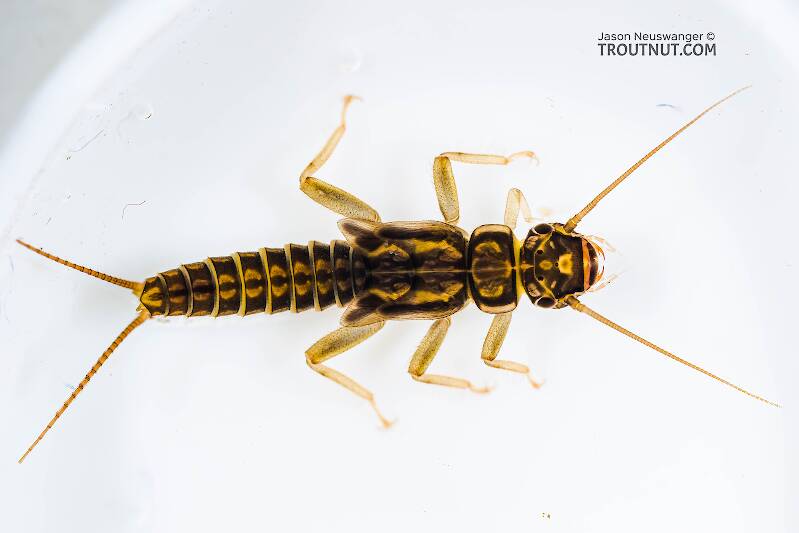
Blue-winged Olives
Baetis
Tiny Baetis mayflies are perhaps the most commonly encountered and imitated by anglers on all American trout streams due to their great abundance, widespread distribution, and trout-friendly emergence habits.


Mayfly Species Thraulodes zonalis
Physical description
Most physical descriptions on Troutnut are direct or slightly edited quotes from the original scientific sources describing or updating the species, although there may be errors in copying them to this website. Such descriptions aren't always definitive, because species often turn out to be more variable than the original describers observed. In some cases, only a single specimen was described! However, they are useful starting points.
Description from GBIFthe Global Biodiversity Information Facility
Source: Systematic position of Thraulodes Ulmer 1920 (Ephemeroptera: Leptophlebiidae) and descriptions of new and little-known species
Descriptions. Larva. CUTICULAR COLORATION (Figs 317 – 320, 328 – 331). Dorsal side of head, thorax and abdomen mostly brown with few blanks: pronotum bordered by light laterally, without other blanks; abdominal terga with blanks on near tergalii bases, area mediad of them nearly unicolorous brown. Femora mostly brown with proximal and preapical blanks; tibia brown; tarsus brown with base and apex lighter. HYPODERMAL COLORATION (Fig. 331). Abdominal terga I – IX with transverse band on posterior margins; terga II – V also with pair of brown spots. Tergalii gray with yellowish (Figs 321 – 327). SHAPE AND SETATION. Clypeus widened distally; labrum 1.3 – 1.4 times wider than clypeus (Fig. 318). Labrum widest at 0.4 length from base; initial fore margin (turned ventrally) without median emargination, with all 5 denticles wide; anterior transverse setal row regular (as in Fig. 88), as wide as all 5 denticles. Maxilla with 15 – 16 pectinate setae in apical-ventral row. Femora: Stout setae on anterior surface parallel-sided and blunt (Fig. 333). Irregular row of hairs near inner margin absent on fore femur, present on middle and hind femora. Fore tibia (Fig. 334): outer hairs form two irregular rows; inner-anterior row of recurved hairs absent; inner-anterior row of stout setae absent or represented by single blunt stout seta near tibia base; inner field of stout pointed setae dense (i. e. setae longer than distances between them, about 3 setae in cross section), setae of most anterior row shorter than others, bipectinate or dentate. Hind tibia (Figs 335 – 336): outer-anterior row of stout setae consists of two clearly different types of stout setae: numerous short rounded ones and several long spoon-like ones; outer-posterior row of stout setae consists of blunt and spoon-like stout setae of various lengths; hairs located between these rows, numerous and form more than one row (besides row of hairs posteriad of outer-posterior row of stout setae); stout setae of inner-anterior row short, widened distally and truncated. Claws with 5 – 7 denticles on rigid portion, with several minute denticles on articulatory portion. Tergalii (Figs 321 – 327): of moderate width; on both lamellae main trachea without branches; dorsal lamella with costal margin most convex in proximal part and anal margin most convex in distal part, gradually narrowed toward apex, with slender apical filament; ventral lamella widest near base, gradually narrowed toward apex, with slender apical filament. Male genitalia in last larval instar (Figs 346 – 347): protogonostyli separated one from another by deep emargination. Each protopenes lobe smoothly stretched to gonopore-bearing process located near median margin; gonopore opened caudally.
Subimago. CUTICULAR COLORATION (Figs 337 – 338). Cuticle brown with lighter brownish and colorless areas. Pronotum light brow. Mesonotum mostly brown, with darker brown antelateroparapsidal and lateroparapsidal sutures, with colorless oblique stripe on posterior scutal protuberance; chromozones of medioscutum and submedioscutum equally colored by brown; chromozones of medioscutum and submedioscutum contrastingly colorless. On all legs femur mostly light, bordered by brown on outer and inner margins, with apex brown; tibia brownish; tarsus lighter brownish. Wings look gray due to blackish microtrichia and small brown ring around base of each microtrichion. Abdominal terga, sterna and microtrichion, caudalii light brownish. TEXTURE. On tarsi of all legs, 1 st tarsomere with microtrichia (as tibia), 2 nd – 5 th tarsomeres coved by blunt microlepides; pointed microlepides present near apical margins of 2 nd – 4 th tarsomeres of middle and hind legs (as in Fig. 473).
Male imago. Described by Traver & Edmunds (1967). Coloration as in female (see below).
Female imago (Figs 338 – 342, 344 – 345). Head and thorax dark brown. Cuticle of legs mostly colorless; on fore leg apex of femur and base of tibia with cuticle brown; on middle and hind legs apex of femur with lighter brownish. Legs with following hypodermal pigmentation on whitish background: Fore femur entirely pigmented, with proximal part blackish-brown and distal part reddish-brown, with blackish stripe along inner margin. Fore tibia mostly reddish-brown, basally and apically darker brown. Fore tarsus light brown with non-pigmented joinings. Middle femur with gray-brown spot on posterior side close to base, larger brown spot on anterior side more distally and multicolored pre-apical band occupying distal half of femur both on anterior and posterior sides; pre-apical band mainly reddish-brown, proximally bordered by blackish brown. Hind femur with large basal brown spot on anterior side, occupying most part of proximal half of femur beginning from its base, and with multicolored pre-apical band as on middle femur. On middle and hind legs tibia mostly non-pigmented, with brown spots near base (close to patella-tibial suture) and on apex; tarsus with small brown spots on 3 rd, 4 th and 5 th tarsomeres. In reared individual, relation of fore femur to fore wing length 80: 350; proportions femur / tibia / tarsomeres on fore leg 80: 80: 4: 7: 7: 5: 10; on middle leg 80: 75: 4: 5: 4: 3: 9; on hind leg 95: 90: 4: 5: 4: 3: 9. Fore wing with dark brown band crossing costal brace. Longitudinal veins ocher or light brown; cross veins light brown, in anterior part of wing narrowly bordered by light brown; costal cross veins proximad of bulla few and very thin, bordered by brown near subcostal vein (Figs 344 – 345). Pterostigmatic cross veins not dense, oblique, non-branched (as in male, Traver & Edmunds 1967: fig. 25). Hind wing short, with costal projection prominent; proximal part of hind wing brown (Fig. 342). Abdomen brown with poorly expressed darker brown midway spots on terga III – V.
Eggs (Figs 348 – 349). Mostly barrel-shaped. Each KTC without ring-like cover, spirally coiled threads being exposed. Other chorion with evenly dispersed protuberances. Dimension. Fore wing length (and approximate body length) 6 – 8 mm.

